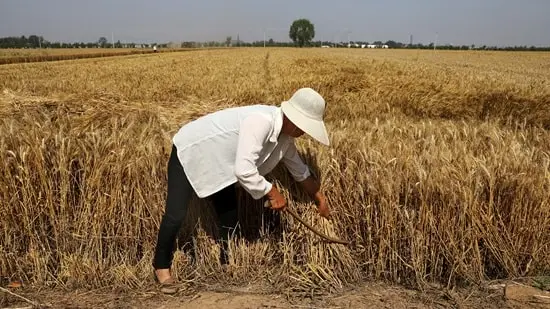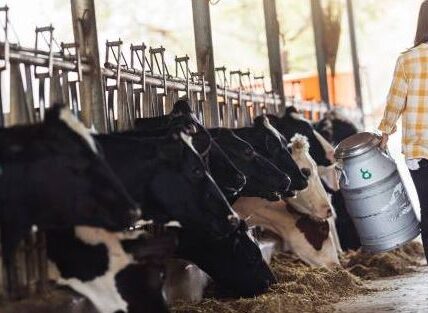Wheat happens to be a very important food all over the world, a staple one for a large part of the global population. Therefore, when it comes to food sustenance, then wheat happens to be the primary focus. As we can see, a good number of countries worldwide have been offering high production of wheat. We will share information about the top 10 countries in the list.
1. China – 134.3 Million Tons
Chinese wheat output tops the globe in 2024 with 134.3 million tons. China, the league’s champion, feeds its massive people with wheat from its lush terrain. Modern agriculture and technology keep the country the world’s top wheat producer. China’s agricultural strength comes from farming big fertile land. Nearly 1.4 billion people face food insecurity. The country’s ability to meet this demand and contribute to the global wheat market underlines its agricultural strategic importance. China’s agricultural R&D boosts crop yield and quality. Innovation helps China’s agricultural business adapt to environmental and economic changes.
2. India – 107.6 Million Tons
India produces 107.6 million tons of wheat, second to China. Indian wheat farming is longstanding and crucial to the nation’s people. Advanced farming technologies and government support have helped India become a worldwide wheat producer. Indian agriculture has grown wheat for generations. India’s farmers serve its huge population with wheat using their knowledge and dedication. In addition to feeding the nation, they influence its culture and economics. Due to intentional agricultural modernization, India produces the most wheat. Precision agriculture, ecological farming, and cutting-edge technology boost wheat yields. This technological development has increased wheat yield and made India a worldwide participant.
3. Russia – 85.9 Million Tons
Russia produces 85.9 million tons of wheat, third in the world, thanks to its rich land. Russia produces most wheat owing to its great climate and land. Given their abundant natural resources, Russian farmers have fully accepted modern agricultural technologies to boost yields and the worldwide wheat market. Russia’s climate and soil support wheat farming. The country’s moderate climate and nutrient-rich soils sustain high-quality wheat. These circumstances allow Russian farmers to use sophisticated agricultural methods to boost output and fulfill local and global market demands. Russia’s superior agricultural methods demonstrate wheat production leadership. Increased yields and sustainability need automation, precision agriculture, and sustainable farming in Russia. Its proactive approach makes Russia a trustworthy and efficient wheat supply chain source.
4. United States – 49.7 Million Tons
The US produces 49.7 million tons of wheat, fourth worldwide. The U.S. leads the globe in wheat output thanks to modern technologies and sustainable farming. The US’s extensive agricultural territory supports wheat crop innovation. American farmers are adaptive and imaginative, so they deploy cutting-edge technologies to enhance yields and ensure wheat supply. Precision agriculture, smart farming, and sustainability have made U.S. agriculture successful worldwide. The US produces wheat globally despite weather and market variations. Despite obstacles, the nation’s agricultural community has reduced external factors’ impact on crop yield. This flexibility and commitment to development make the U.S. a global wheat leader.
5. Canada – 35.2 Million Tons
Canada produces 35.2 million tons of wheat, sixth worldwide. Its vast plains and sustainable agriculture distinguish it. Canadian wheat growers are environmentally sensitive and produce high-quality wheat. Canada’s agriculture business leverages its vast grasslands to promote global wheat production. High-quality Canadian wheat is prized internationally. The country’s commitment to these objectives highlights its role as a quantity and quality wheat producer. Canadian wheat farmers use sustainable agriculture. To lessen their environmental effect, Canadian farms go green. Sustainable farming technologies like precision agriculture and conservation tillage balance productivity and the environment.
6. France – 30.1 Million Tons
France is known for its cuisine, ranks sixth in wheat output with 30.1 million tons. The country’s combination of traditional and contemporary farming methods ensures a steady wheat supply for local and international markets, in addition to its culinary fame. France’s dedication to agriculture makes it a top wheat producer. Wheat agriculture in France is a symphony of ancient and modern methods. The country’s farmers use a unique blend of old wisdom and contemporary technology. French agriculture’s cultural history is preserved while meeting the needs of a dynamic global market via efficiency and innovation. France supplies wheat to its own selective consumers and worldwide markets. French wheat is appreciated worldwide for its quality and uniqueness. The nation’s success in the global wheat market is due to its excellent farming and processing standards.
7. Pakistan – 25.2 Million Tons
Pakistan produces 25.2 million tons of wheat, seventh worldwide. The nation’s diversified agricultural landscape and food depend on wheat. Pakistani farmers use agricultural advances to increase yield and provide wheat worldwide. People need wheat for their diets. Geographically and climatically diverse, Pakistan’s agricultural terrain is complicated. The nation prioritizes wheat, a main crop, to feed its diverse population. For Pakistan’s nutritional needs, farmers must adapt to this diverse terrain and produce enough wheat. To increase wheat production, Pakistani farmers swiftly embraced innovative farming practices. Pakistan is committed to agricultural innovation with precision agriculture, better irrigation, and high-yielding wheat varieties. These novel approaches meet local wheat demand and make Pakistan a global wheat powerhouse.
8. Ukraine – 24.9 Million Tons
Due to its rich black soil and favorable climate, Ukraine produces 24.9 million tons of wheat, sixth globally. The farm industry has changed thanks to technology and sustainability. Ukraine’s wheat is becoming essential to the world food supply. Ukrainian wheat is grown on Chernozem’s dark soil. These natural resources and a healthy climate allow for large-scale wheat production. Ukrainian farmers harness these agricultural marvels and employ modern technologies to boost yields and protect soil health. Ukraine’s agricultural sector intentionally upgraded. Precision agriculture, greater irrigation, and improved seed varieties have boosted Ukrainian wheat fields’ efficiency and yield. Innovative solutions meet changing agricultural demands and make Ukraine a global wheat leader.
9. Germany – 22.2 Million Tons
European powerhouse Germany produces 22.2 million tons of wheat, ninth worldwide. German farmers guarantee wheat supply using precision agriculture and efficient technology. Despite its smaller geographical area, Germany is a leading wheat producer due to its agricultural innovation. German agriculture succeeds due of precision agriculture. German farmers boost crop yield using GPS-guided tractors and sensor-based monitoring. The precision ensures a steady wheat supply and resource efficiency and sustainability. German farming practices efficiently utilize land. Germany’s farmers produce more with technology and smart management than other agricultural giants while having less land. Germany consistently dominates the worldwide wheat market due to efficiency.
10. Turkey – 20.5 Million Tons
Turkey produces 20.5 million tons of wheat, ranking 10th globally. Turkish farmers produce wheat because of their strategic location between Europe and Asia and diverse climate. Turkey leads global wheat production, demonstrating how regional players determine and guarantee food security. Turkey’s position between Europe and Asia promotes wheat output. Farmers exploit the country’s weather. Turkish farmers are resilient and adaptable, adapting to varied conditions. Turkey’s 20.5 million tons of wheat exports demonstrate its significance in the food supply chain. Turkey actively produces wheat to suit global demand. Regional contributions like Turkey are essential to a stable global food system, showing how interconnected nations are.
Conclusion
The global agricultural picture is quite diverse and the role played by these 10 countries in wheat production is quite important here. With new innovative steps in wheat cultivation, engagement of specialist to better the cultivations, employees best efforts and manpower, these countries made it possible to reach their production goals every year.

Brandon is the cheif editor and writer at WorldUnfolds.com. With a passion for storytelling and a keen editorial eye, he crafts engaging content that captivates and enlightens readers worldwide.















